This post may contain affiliate links. Please see our disclosure policy.
Chive Blossom Jelly is a savory jelly with surprising flavor. It’s perfect on biscuits or alongside cheeses on a charcuterie plate.
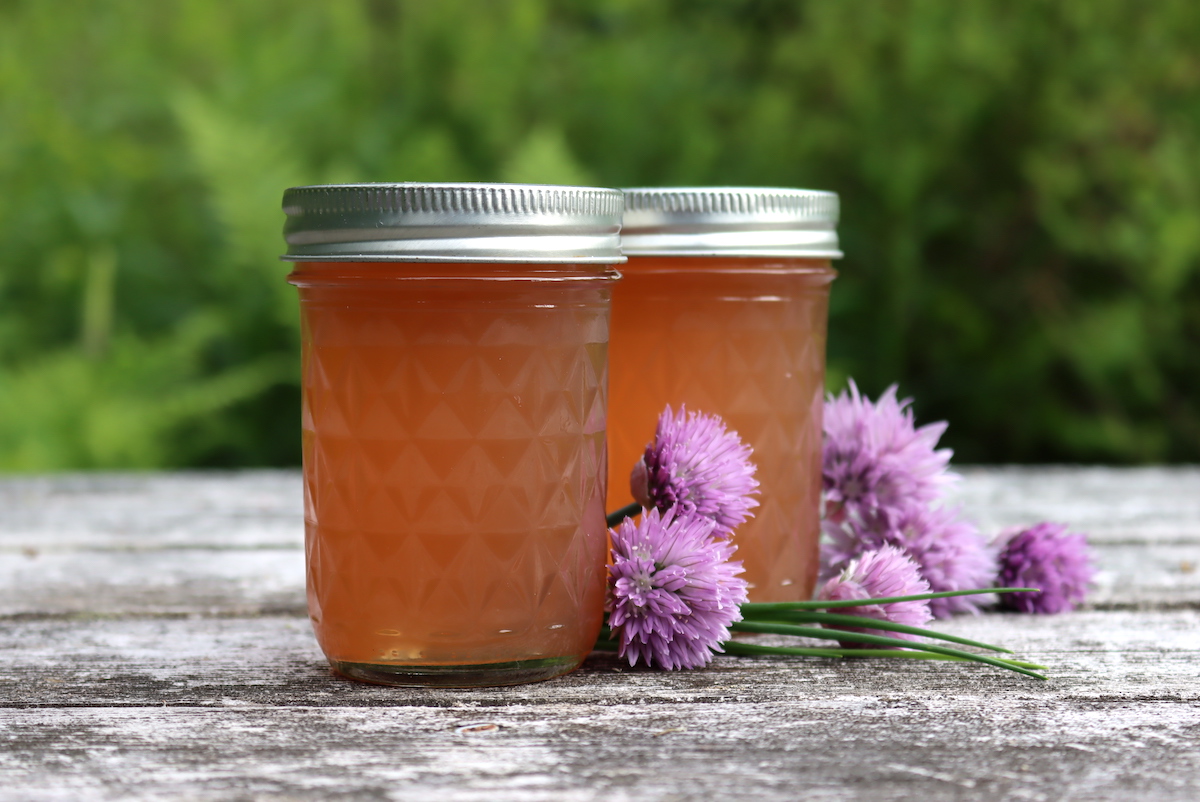
This past year, I started experimenting with making savory herbal jellies to enjoy on homemade charcuterie plates, alongside crackers and cheese.
Some herbs do really well in a sweet context, and for those, I just use my basic floral jelly recipe (just using herbs instead of blossoms). Some flowers, however, really want to be savory…and chive blossoms definitely fall into the savory category.
Jellies still do need some sugar, but in this case, those sweet flavors are balanced out with wine vinegar and a splash of white wine too.
Ultimately, it’s perfectly balanced and full of incredible herbal flavor.
A Quick Look at the Recipe
- Recipe Name: Chive Blossom Jelly
- Recipe Type: Flower Jelly Recipe
- Canning Method: Waterbath Canning
- Prep/Cook Time: 30 Minutes
- Canning Time: 10 Minutes
- Yield: 4 to 5 half pint jars
- Jar Sizes: Quarter Pint, Half Pint or Pint
- Headspace: 1/4 inch
- Ingredients Overview: Edible Flowers, Water, Lemon Juice (not optional), and sugar
- Difficulty: Easy! You’re basically making a quick tea and setting it with pectin.
- Similar Recipes: The process is very similar to making other herbal jelly, including Bee Balm Jelly, Lemon balm Jelly, Nasturtium Jelly, or Borage Jelly.
Ingredients for Chive Blossom Jelly
This recipe will yield about 5 half-pint jars (8 oz each) of chive blossom jelly. You’ll need the following ingredients:
- 2 cups fresh chive blossoms (or 1 cup dried chive blossoms)
- 1 box (1.75 oz) low-sugar pectin (such as Sure Jel Low Sugar)
- 1 to 2 cups sugar
- 1 cup vinegar (either wine vinegar, white, cider, or rice vinegar)* see notes
- ¼ cup lemon juice
- 4 cups water (or 2 cups water and 2 cups white wine)
Adding white wine can help balance out the sweetness and lend interesting flavors to herbal jellies. The addition of vinegar and lemon juice will do the same, balancing taste and sweetness. Lemon juice, in addition, helps to preserve the jelly when canning.
For the vinegar here, I’d strongly suggest you go with something mild like white wine vinegar or champagne vinegar. Plain white vinegar can be abrasive, but it will work if that’s all you have.
Rice vinegar is also a good neutral choice, and is a bit less acidic (which is fine in this recipe, even if canning).
Lastly, you can use apple cider vinegar, and while the flavor is good, it will impact the color of the finished jelly. With cider vinegar, it’ll be brown instead of a vibrant pink.
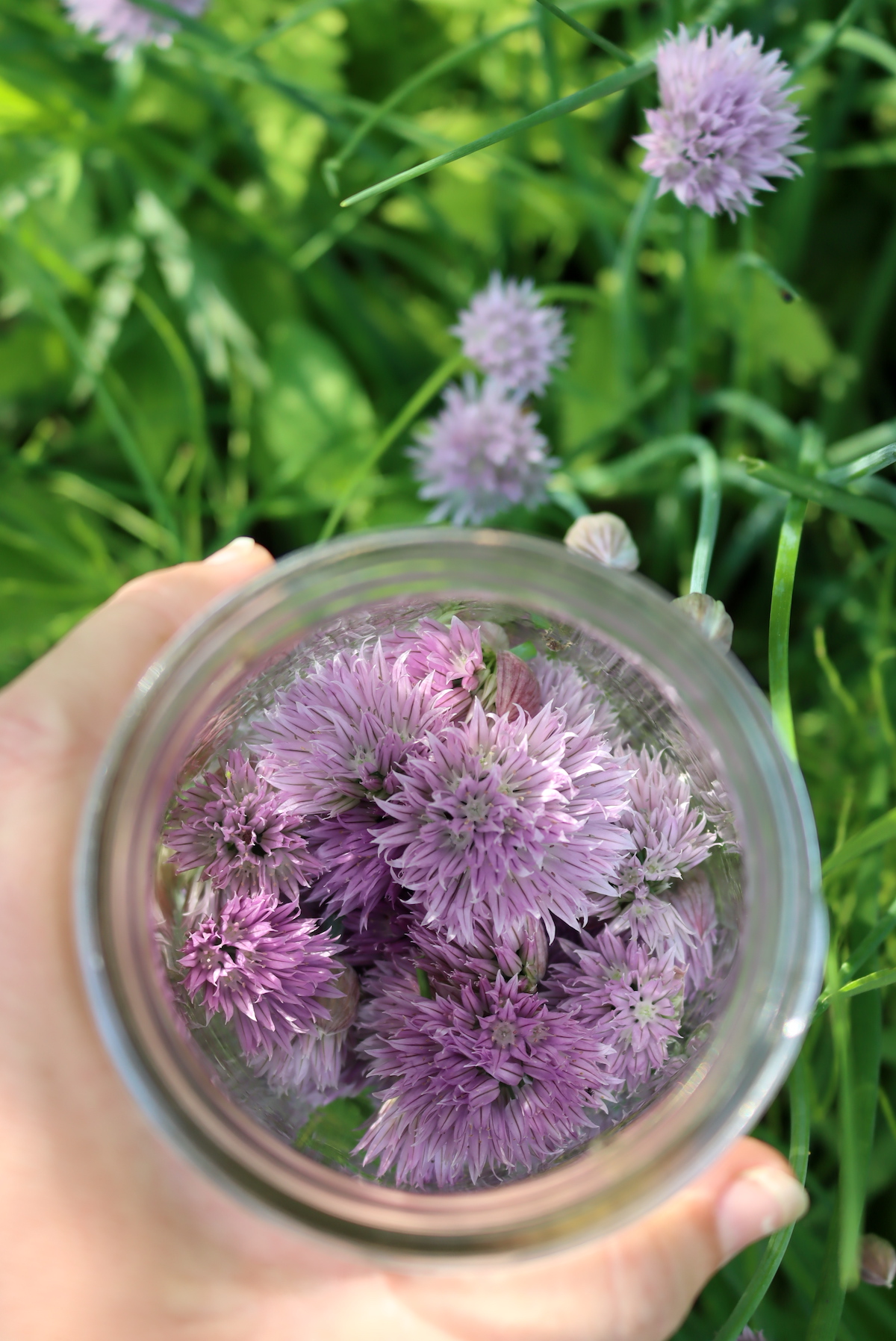
How to Make Chive Blossom Jelly
This jelly begins with chive blossoms, which give it its savory, onion-like flavor. If collecting your chive blossoms, be sure to harvest them from an area that is pesticide, herbicide, and pollutant-free and clean before use.
You’ll need 2 cups of fresh chive blossoms, washed and chopped. Dried chive blossoms can also be used, but due to their more pungent nature, you’ll only want to use 1 cup.
Now it is time to make a chive blossom tea. Take your chopped chive blossoms and place in a heat-safe container. Pour 4 cups boiling water (or a boiling mixture of 2 cups water and 2 cups white wine) over the leaves and allow to steep for 10 to 15 minutes. Add the lemon juice while it’s steeping, as the lemon helps pull out the color from the blossoms.
Next, strain the chive blossoms from the mixture using a fine mesh strainer or cheesecloth and discard – you’ll only need the tea for the remainder of the recipe.
Place the liquid in a saucepan or jam pot and add the vinegar, and pectin, stirring to incorporate. Return to a boil.
Boil the mixture one full minute before adding in your sugar.
After this minute has passed, add in the sugar and stir to dissolve, boiling for another full minute. Remove from heat.
Now, the fun part! Ladle your jelly into prepared jars, ensuring you leave ¼ inch headspace.
If canning for long-term or non-refrigerated storage, process in a water bath canner for 10 minutes (or 15 minutes if above 6,000 feet in elevation). If refrigerating or freezing, simply allow jars to cool to room temperature before moving to these locations.
Refrigerated jellies will keep up to one month while freezer jellies will keep 6 months. When properly sealed, canned jellies will keep 12 to 18 months.
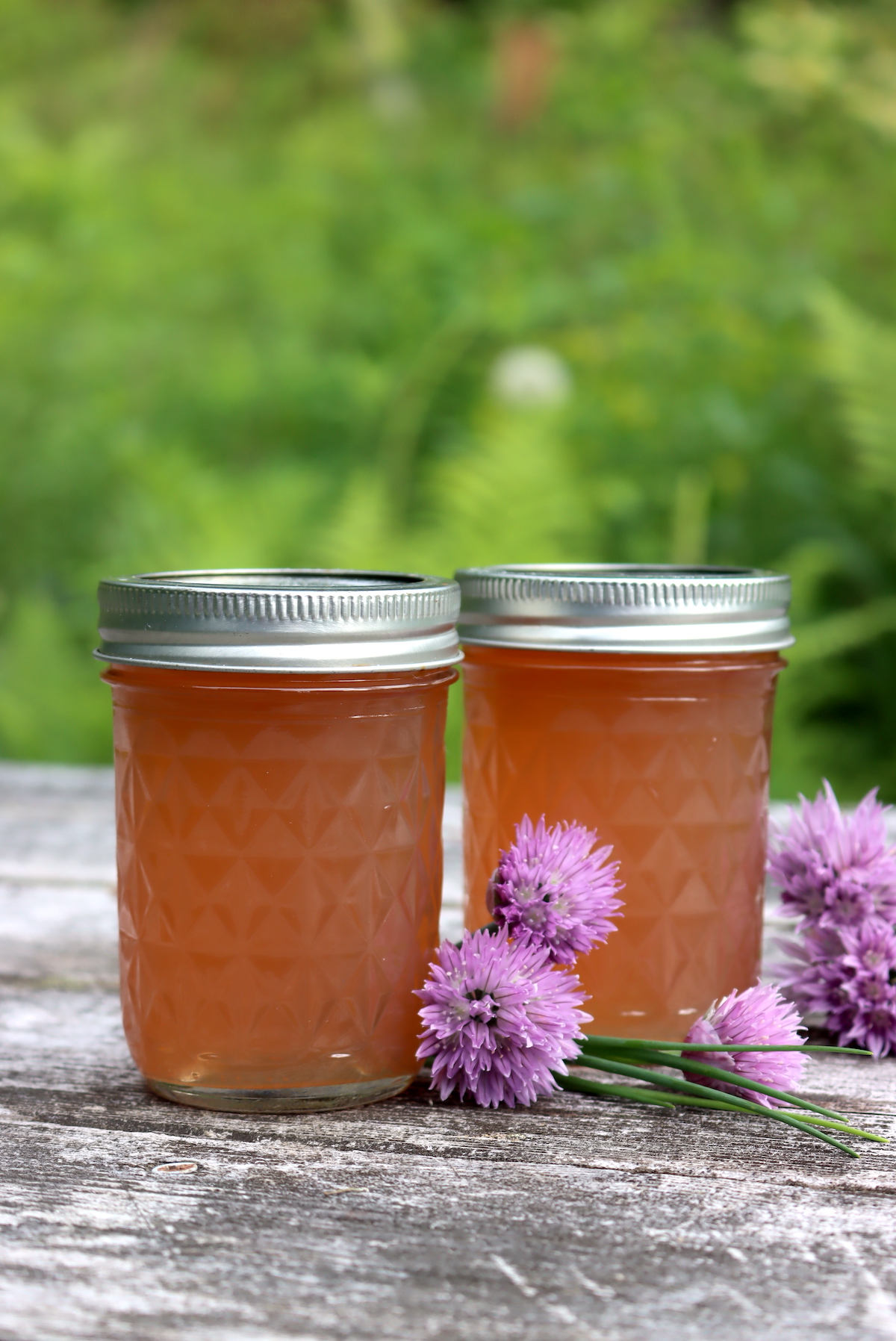
Chive Blossom Jelly Variations
Chive blossoms make an appetizing savory jelly, but sweeter variations can be made as well. Add more sugar (up to 4 cups total) for a sweet and spicy chive blossom jelly. Fruit and vegetable-based jellies or jams can be made with the addition of orange, onions, or tomatoes.
Still can’t get enough chive blossoms? Other culinary creations can be made from these pungent herbs. Consider using leftover chive blossoms to make chive blossom vinegar or chive blossom butter.
Add chive blossoms to baked recipes to make savory biscuits or bread. Unused stems can be saved for chive pesto, while fresh blossoms can top salads or elaborate pasta dishes.
Canning Chive Blossom Jelly
Always prepare and sterilize jars before beginning your jelly – that way you can immediately spoon or ladle jelly into jars for canning.
Once your jelly has reached the necessary consistency, you can remove it from heat and place into your sparkling clean jars, leaving ¼ headspace. Clean the tops of the jars of any lingering jelly with a damp cloth to ensure tight, clean seals.
Apply 2-part canning lids, close tightly, and process in a water bath canner for 10 minutes (add another 5 minutes if above 6,000 feet elevation). Carefully remove and allow to cool.
As usual, it’s a good idea to check your seals after 12 to 24 hours to make sure your jelly has been properly canned. Button lids should be indented downward and if tapped on with a spoon, emit a high-pitched ring as opposed to a lower-toned one.
Any unsealed jars should be refrigerated and consumed within a month. Properly canned jellies will keep up to 18 months and should be refrigerated once opened.
Ways to Use Chive Blossom Jelly
This garlicky, lightly floral jelly can be used in a variety of ways. It makes a lovely accessory to savory charcuterie boards when paired with meats, crackers, cornichons, and goat cheese. Chive blossom jelly can also be used to accompany roasted meats such as pork or chicken as a glaze during cooking or afterwards condiment-style.
Looking to add some flavor to leftover cold cuts? Try spreading chive blossom jelly on turkey and chicken sandwiches for extra savory satisfaction.
I think it works wonderfully with savory crackers and a bit of brie…

Chive Blossom Recipes
Looking for more ways to use chive blossoms?
If you tried this Chive Blossom Jelly Recipe, or any other recipe on Creative Canning, leave a ⭐ star rating and let me know what you think in the 📝 comments below!
And make sure you stay in touch with me by following on social media!
Flower Jelly Recipes
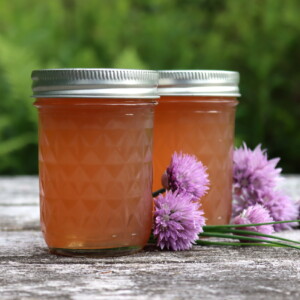
Savory Chive Blossom Jelly
Equipment
Ingredients
- 2 cups fresh chive blossoms, or 1 cup dried chive blossoms
- 1 box low sugar pectin, 1.75 oz, such as Sure Jell No Sugar
- 1 to 2 cup sugar
- 1 cup vinegar, either wine vinegar, white, cider or rice
- ¼ cup lemon juice
- 4 cups water, or 2 cups water and 2 cups white wine
Instructions
- Start by properly cleaning and sterilizing your jars before proceeding to make your jelly.
- If using fresh chive blossoms, clean and chop the batch. You’ll need 2 cups of fresh blossoms or 1 cup of dried blossoms.
- Next, brew your blossom tea. Add the blossoms to a heat-safe container and cover with either 4 cups boiling water or your mixture of white wine and water. Add the lemon juice while the tea steeps, as it helps to bring out more color from the blossoms.
- Steep for 10 to 15 minutes.
- Strain the blossoms from the liquid and discard them. Pour the liquid into a large pan or jam pot and add in the vinegar and pectin. Return to boil and boil for a full minute before proceeding to the next step.
- Add in the sugar, stir, return to boil and boil for another full minute. Remove from heat.
- Ladle jelly into freshly prepared canning jars, leaving ¼ headspace. Clean the rims of any remaining residue and apply two parts lids.
- If canning, process the jars in a water bath canner for 10 minutes. Refrigerated jellies may be stored in the refrigerator or freezer once cooled to room temperature.
Notes
Nutrition
Nutrition information is automatically calculated, so should only be used as an approximation.
This particular recipe is absolutely delicious as a savory jelly, but you can also make savory jams, including garlic scape jam, tomato jam and caramelized onion jam.
Herbal and Flower Jellies
Looking for more flavorful herbal or flower jellies?
- How to Make a Herbal Jelly (Savory or Sweet)
- How to Make a Flower Jelly (with Any Edible Flower)
- Rose Petal Jelly
- Redbud Jelly
- Lilac Jelly
- Dandelion Jelly
Spring Jelly Recipes
This season is the perfect time for stocking your pantry full of homemade jelly!
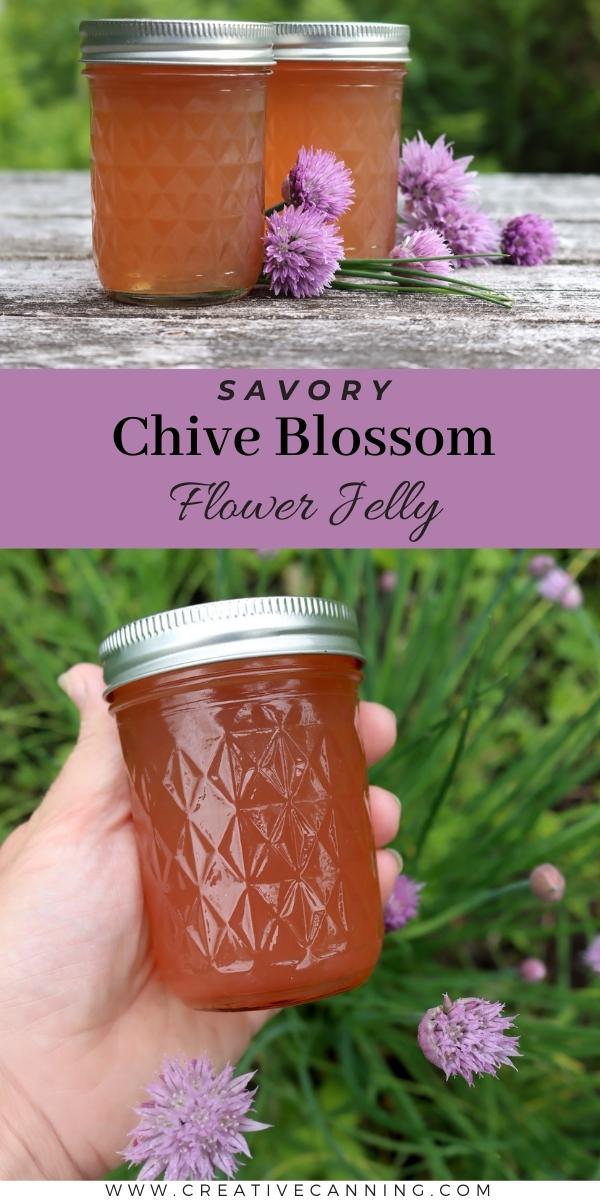
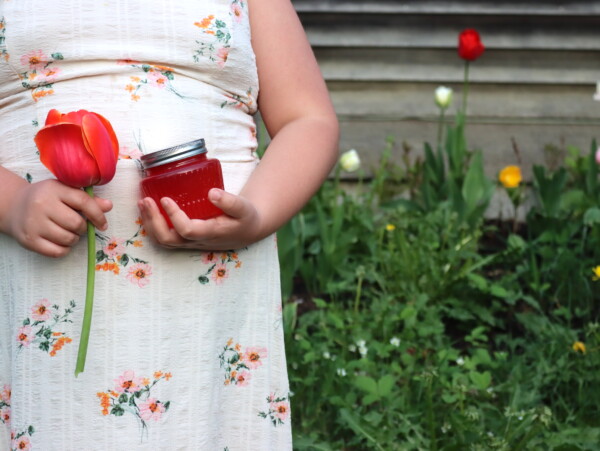
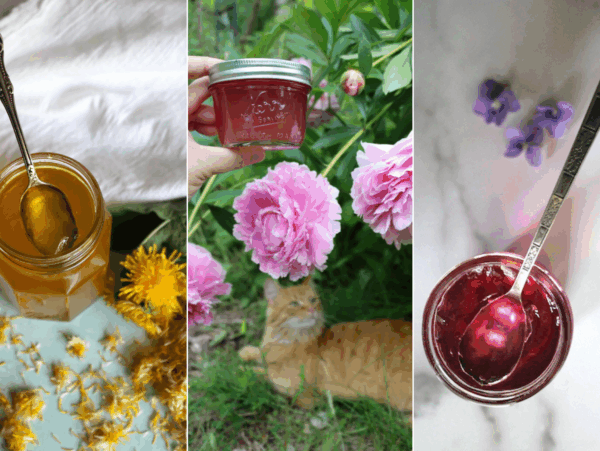
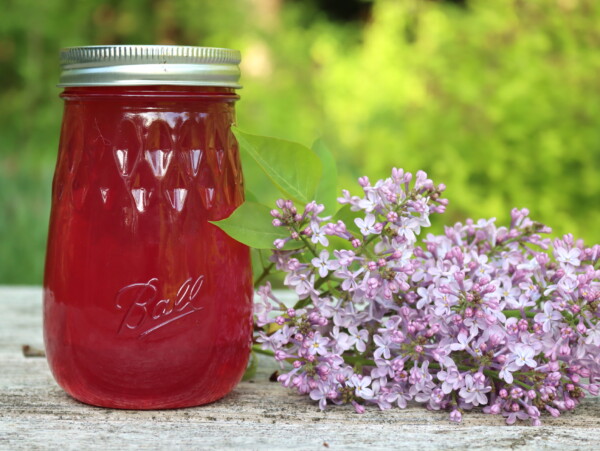
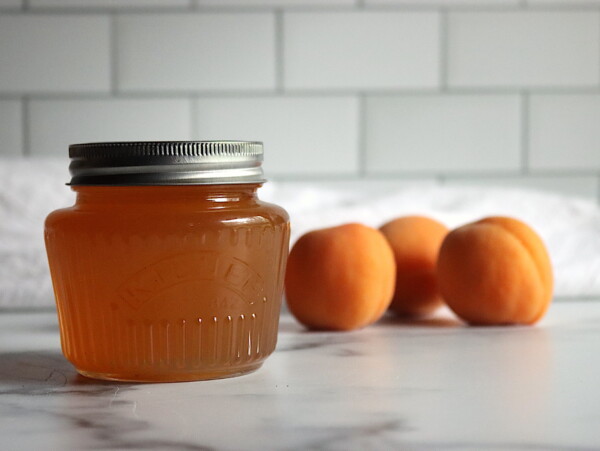
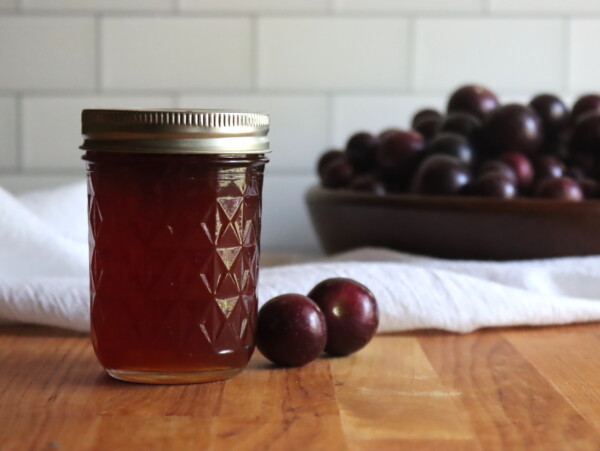
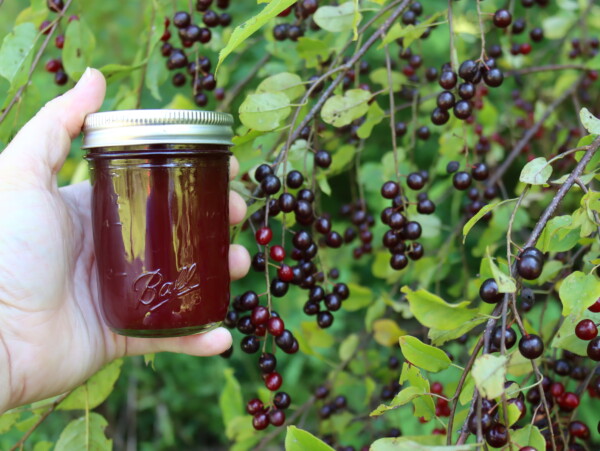
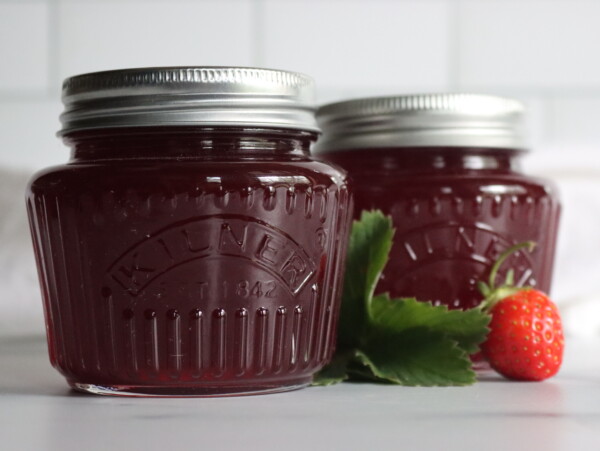
Hi Ashley! I made your Chive Blossom jelly and it turned out beautifully! I sprinkled a few tiny individual blossoms in each jar which then floated up to the top after I poured the hot jelly in. A pretty little surprise when someone opens the jar! Can’t wait to serve on father’s day with cheese and crackers!
That’s lovely!
Just made this and it’s cooling as I type. Have you found a low sugar pectin that preserves the purple color? I used Ball and it has a slight brown tint to it that muddied the jelly a little. Is Sure Jel better for color?
Sure Jel gives perfect color without any change to it, both their regular and low sugar pectin are great like that. Watch your sugar too. It has to be white cane sugar (as the organic sugar, sometimes called evaporated cane juice will also give it a bit of a brown color since it has some molasses in it).